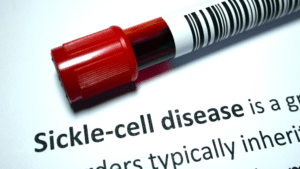The genetic condition that affects the body’s red blood cells, leading to episodes of severe pain and other complications, is called Sickle cell disease (SCD). Effective management of SCD is crucial for enhancing patients’ quality of life. Let’s delve into a detailed exploration of its treatments.
Understanding Sickle Cell Disease: A Brief Recap
Sickle cell disease is a hereditary condition characterized by the production of abnormally shaped red blood cells. Instead of being round and flexible, they resemble sickles, leading to many health issues.

Current Treatment Options for Sickle Cell Disease
Pain Management
Pain episodes, often called sickle cell crises, are a primary concern for SCD patients.
- Pain-relieving Medications: Over-the-counter pain relievers and stronger prescription medicines play a vital role. Some commonly prescribed options include acetaminophen, ibuprofen, and opioids for severe pain.
- Heating Pads: Applied locally, these can alleviate pain and enhance blood flow.
- Blood Transfusions
Regular blood transfusions can reduce stroke risk in children with sickle cell disease and alleviate symptoms.
- Red Blood Cell Transfusions: Replaces the sickled cells with normal ones, enhancing oxygen delivery.
- Exchange Transfusions: A simultaneous process where sickled blood is removed and replaced with fresh, normal blood.
Medications
Several medications have shown promise in managing and reducing SCD complications.
- Hydroxyurea: Reduces the frequency of painful episodes and the need for blood transfusions.
- L-glutamine Oral Powder: Helps reduce the acute complications of SCD in adults and children over five.
- Endari: An amino acid that aids in reducing the frequency of pain crises.
Stem Cell Transplant
Stem cell or Bone Marrow transplants offer a potential cure for SCD, especially in children. It involves replacing the bone marrow affected by SCD with healthy donor marrow.
Lifestyle and Home Remedies
- Stay Hydrated: Drinking the right amount of water helps keep blood cells hydrated, reducing the risk of sickling.
- Avoid High Altitudes: Places with reduced oxygen can trigger a sickle cell crisis.
- Manage Stress: Stress-relieving activities can reduce the occurrence of crises.
Potential Future Treatments
Research into sickle cell disease treatments is ongoing, with many promising therapies in the pipeline. Gene therapy, in particular, has emerged as a potential future treatment option, aiming to introduce or alter genetic material within a person’s cells to fight or prevent disease.
Conclusion
Patients and caregivers must understand and stay updated on the latest treatment options for sickle cell disease. While we’ve covered the most prominent treatments currently available, always consult with a healthcare professional for a tailored approach to managing SCD. The future looks promising with the advent of advanced treatments like gene therapy, offering hope to those living with this challenging condition.

